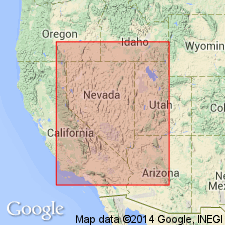
- Usage in publication:
-
- Greenwater Fan Alloformation
- Modifications:
-
- Named
- Dominant lithology:
-
- Siltstone
- Claystone
- Sandstone
- Tephra
- AAPG geologic province:
-
- Great Basin province
Summary:
Named Greenwater Fan Alloformation and assigned, along with (ascending), Spanish Trail, Shoshone Springs, and Amargosa Alloformations (all new) to late Miocene to Pleistocene Lake Tecopa Allogroup (new). Name origin not stated. Found in ancient Lake Tecopa area, eastern Mojave Desert, vicinity of intermittent Amargosa River and towns of Shoshone and Tecopa, Inyo Co., east-central CA. Exposed only in deeply dissected interiors of south-central part of Tecopa basin. Consists entirely of basin-lowland sediments, such as thin-bedded to laminated siltstone, claystone, some fine sandstone (no gravel), plus basal late Pliocene (2.0 Ma) Huckleberry Ridge, early Pleistocene (1.0 Ma) Glass Mountain G, early Pleistocene (0.9 Ma) Glass Mountain D tephra layers, and other tephra layers of unknown source and age. Mean thickness is 18 m. Discontinuously underlies early Pleistocene (738 ka) Bishop tephra layer (of Shoshone Springs Alloformation). Discontinuously overlies Spanish Trail Alloformation. Age ranges from late Pliocene (2 Ma) to latest early Pleistocene (0.74 Ma) based on well-dated tephra layers (Sarna-Wojcicki and others, 1987; Chapter 6 in this volume; Sarna-Wojcicki, personal communication, 1990).
Source: GNU records (USGS DDS-6; Menlo GNULEX).
For more information, please contact Nancy Stamm, Geologic Names Committee Secretary.
Asterisk (*) indicates published by U.S. Geological Survey authors.
"No current usage" (†) implies that a name has been abandoned or has fallen into disuse. Former usage and, if known, replacement name given in parentheses ( ).
Slash (/) indicates name conflicts with nomenclatural guidelines (CSN, 1933; ACSN, 1961, 1970; NACSN, 1983, 2005, 2021). May be explained within brackets ([ ]).

